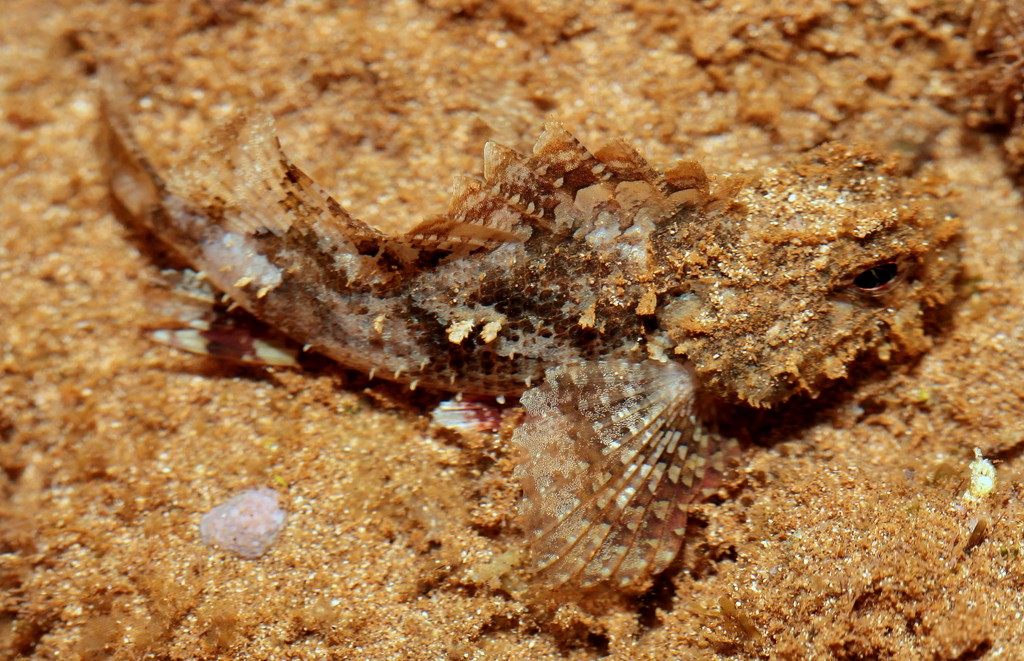SCORPAENODES KELLOGGI - (JENKINS, 1903)
Actinopterygii (Gigaclass) > Actinopteri (Class) > Teleostei (Subclass) > Perciformes (Order) > Scorpaenoidei (Suborder) > Scorpaenidae (Family) > Scorpaeninae (Subfamily) > Scorpaenodes (Genus)
Kellogg's scorpionfish, Dwarf scorpionfish, Dwerg-skerpioenvis, Guamukasago,
Synonymes
Scorpaenodes keelingensis (Marshall, 1950)
Kellogg's scorpionfish, Dwarf scorpionfish, Dwerg-skerpioenvis, Guamukasago,
Synonymes
Scorpaenodes keelingensis (Marshall, 1950)
Sebastopsis kelloggi (Jenkins, 1903)
--------------------------
Description
Dorsal spines (total): 13; Dorsal soft rays (total): 7-8; Anal spines: 3; Anal soft rays: 5. With spotted caudal fin; 3-4 spinous points on suborbital ridge; interorbital spines present; no small spines at midline between tympanic spines. Max length: 5.0 cm TL. Depth range: 6 - 24 m.
This species has small dermal cirri on some of the cranial spines, the one on the supraocular about equal to diameter of pupil; scales ctenoid on body and on head except snout and under side of head, maxillary probably naked too; palatine teeth absent; preorbital bone without the usual spines along the lower edge, rounded projections at places where the two spines usually occur; a short spine on interorbital ridge; concave notch at tip of premaxUlary and symphysial knob at tip of lower jaw both small.
Etymology
Scorpaenodes: from ancient Greek, skórpaina = scorpion, name of Scorpaena scrofa + from Greek suffix, -oides = resembling, similar to. Referring to its dorsal-fin spines, which can inflict a painful wound, like the sting of a scorpion.
kelloggi: Named after Prof. Vernon Lyman Kellogg (December 1, 1867 in Emporia, Kansas – August 8, 1937 in Hartford, Connecticut) was a U.S. entomologist, evolutionary biologist, and science administrator (department of entomology, Leland Standford Junior University).
Original description: Sebastopsis kelloggi Jenkins, 1903 - Type locality: Honolulu, Oahu Island, Hawaiian Islands.
Distribution
Indo-Pacific: East Africa to the Hawaiian, Line, and Society islands, north to Taiwan, south to northern Australia; throughout Micronesia. Reported from New Caledonia.
Biology
Occurs in coralline areas from near shore to the outer reef slope at a depth of at least 24 m. Benthic. Anterolateral glandular groove with venom gland.
--------------------------
Description
Dorsal spines (total): 13; Dorsal soft rays (total): 7-8; Anal spines: 3; Anal soft rays: 5. With spotted caudal fin; 3-4 spinous points on suborbital ridge; interorbital spines present; no small spines at midline between tympanic spines. Max length: 5.0 cm TL. Depth range: 6 - 24 m.
This species has small dermal cirri on some of the cranial spines, the one on the supraocular about equal to diameter of pupil; scales ctenoid on body and on head except snout and under side of head, maxillary probably naked too; palatine teeth absent; preorbital bone without the usual spines along the lower edge, rounded projections at places where the two spines usually occur; a short spine on interorbital ridge; concave notch at tip of premaxUlary and symphysial knob at tip of lower jaw both small.
Etymology
Scorpaenodes: from ancient Greek, skórpaina = scorpion, name of Scorpaena scrofa + from Greek suffix, -oides = resembling, similar to. Referring to its dorsal-fin spines, which can inflict a painful wound, like the sting of a scorpion.
kelloggi: Named after Prof. Vernon Lyman Kellogg (December 1, 1867 in Emporia, Kansas – August 8, 1937 in Hartford, Connecticut) was a U.S. entomologist, evolutionary biologist, and science administrator (department of entomology, Leland Standford Junior University).
Original description: Sebastopsis kelloggi Jenkins, 1903 - Type locality: Honolulu, Oahu Island, Hawaiian Islands.
Distribution
Indo-Pacific: East Africa to the Hawaiian, Line, and Society islands, north to Taiwan, south to northern Australia; throughout Micronesia. Reported from New Caledonia.
Biology
Occurs in coralline areas from near shore to the outer reef slope at a depth of at least 24 m. Benthic. Anterolateral glandular groove with venom gland.
